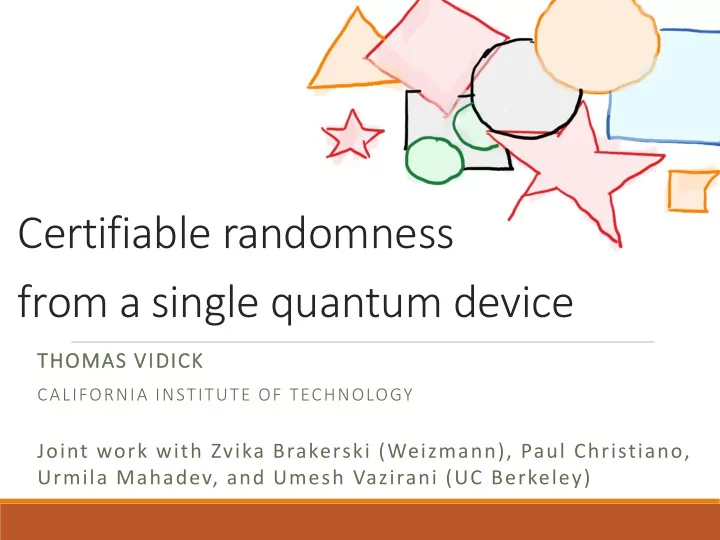

Certifiable randomness from a single quantum device THOMAS VIDICK CALIFORNIA INSTITUTE OF TECHNOLOGY Joint work with Zvika Brakerski (Weizmann), Paul Christiano, Urmila Mahadev, and Umesh Vazirani (UC Berkeley)
Quantum Computing 1.0 • [Wiesner’83,Bennett - Brassard’84] Information-theoretic security in quantum cryptography • [Shor’94],[ Aharonov-Ben-Or,Gottesman,Shor,Preskill ‘96 -97] Fault-tolerant quantum computers can factor in polynomial time The D-Wave 2000Q • [Bernstein- Vazirani’97] Quantum computing as a challenge to the efficient Church-Turing thesis [ … 20 years pass … ] Quantum Computing 2.0 • [Preskill’18] The NISQ era • No fault- tolerance in sight… … but nearing experimental test of Google 72- qubit “Bristlecone” chip extended Church-Turing thesis?
Demonstrating quantum advantage in the NISQ era • [Aaronson- Arkhipov’10] [Bremner-Jozsa- Shepherd’10] Boson Sampling Instantaneous Quantum Computation (IQP) • [Boixo et al.’16] Random quantum circuits • Artificial tasks designed for 50-60 qubit devices • Verification does not scale; poor tolerance to errors • Limited characterization of quantum device verifiable quantumness ? 50 noisy qubits: 2000 perfect qubits ( × 100 for QEC) verified quantum advantage break ECC
A new proposal • Assumptions: • Quantum device is computationally bounded • Verifier has trapdoor information for Quantum device post-quantum secure cryptographic scheme • Goals: • Efficient verification • Characterization of device • Useful task Classical verifier
Protocol for certifying quantumness Device Verifier public parameters 𝑞𝑙 commitment 𝑧 challenge 0/1 response 𝑠 0 /𝑠 1 • Verifier uses trapdoor 𝑢 𝑙 to check device’s responses • Show: No poly-time (classical or quantum) procedure can compute both 𝑠 0 and 𝑠 1 1 • Conclude: Classical device cannot succeed with probability ≫ 2 : classical devices can be rewound! • Protocol forces efficient device to implement collapsing measurement
Trapdoor claw-free functions Function 𝑔: 0,1 𝑜+1 → 0,1 𝑜 such that: 𝑦 0 • 𝑔 is two to one 𝑧 𝑦 1 • Hard to find claws : pairs (𝑦 0 , 𝑦 1 ) s.t. 𝑔 𝑦 0 = 𝑔(𝑦 1 ) • Given trapdoor 𝑢 𝑙 , can invert 𝑧 and find 𝑦 0 , 𝑦 1 s.t. 𝑔 𝑦 0 = 𝑔 𝑦 1 = 𝑧 • Prepare uniform superposition over |𝑦〉 , evaluate 𝑔 and measure outcome 𝑧 : 1 𝑦 0 + 1 |𝑦 1 〉 2 2 • Measure in computational basis: 𝑦 0 or 𝑦 1 • Measure in Hadamard basis: 𝑒 such that 𝑒 ⋅ 𝑦 0 ⊕ 𝑦 1 = 0 • LWE instantiation with hardcore bit property: ( 𝑦 0 or 𝑦 1 ) and ( 𝑒 s.t. 𝑒 ⋅ 𝑦 0 ⊕ 𝑦 1 = 0 ) hard to find
Protocol for certifying quantumness Device public parameters 𝑞𝑙 Verifier commitment 𝑧 challenge 𝑑 = 0/1 𝑑 = 0: 𝑦 0 or 𝑦 1 𝑑 = 1: 𝑒 s.t. 𝑒 ⋅ 𝑦 0 ⊕ 𝑦 1 = 0 • Verifier uses trapdoor 𝑢 𝑙 to invert 𝑧 and check answers • Hardcore bit property: no poly-time device can answer both challenges • Successful device must be quantum!
Certified randomness expansion • Quantum devices can generate randomness • Can we prove that the outcome is random? • [Colbeck’09,…] Bell inequality violation certifies generation of randomness • [MS’15,AFDFRV’18] Violation → mutually unbiased measurements → randomness accumulation
Protocol for certified randomness expansion public parameters 𝑞𝑙 Device Verifier commitment 𝑧 challenge 𝑑 = 0/1 𝑑 = 0: 𝑦 0 or 𝑦 1 𝑑 = 1: 𝑒 s.t. 𝑒 ⋅ 𝑦 0 ⊕ 𝑦 1 = 0 • Verifier and device interact for 𝑂 rounds: • In most rounds, 𝑑 = 0 . Verifier records device’s choice of pre -image • With small frequency, select 𝑑 = 1 and check equation • Pseudorandomly refresh crypto keys after each equation check • Verifier extracts randomness from 𝑑 = 0 (preimage) rounds
Protocol for certified randomness expansion public parameters 𝑞𝑙 Device Verifier commitment 𝑧 challenge 𝑑 = 0/1 𝑑 = 0: 𝑦 0 or 𝑦 1 𝑑 = 1: 𝑒 s.t. 𝑒 ⋅ 𝑦 0 ⊕ 𝑦 1 = 0 • Security proof: hardcore bit property → device’s measurements unbiased • In each round, device measures an “effective qubit” • In the computational basis if 𝑑 = 0 (outcome is preimage choice) • In the Hadamard basis if 𝑑 = 1 (outcome is equation validity) • Valid equation → “effective qubit” is in |+⟩ state → computational basis measurement generates randomness • Randomness accumulation requires delicate adaptation of [MS’15,ADFRV’18]
Certifying quantum devices • Two entangled devices • Single computationally bounded device • Bell inequality violation implies • Certified qubit → certified randomness EPR pair + Pauli measurements (rigidity) • [Mahadev’18] Homomorphic encryption • Certified randomness expansion [VV,MS’14] • [Mahadev’18] Verified delegation • Device-independent cryptography [VV,MS’14] • … more to come !? • Delegated computation [RUV’13,CGJV’17]
Summary and open questions • Classical verifier has four-message interaction with untrusted device • Device succeeds in test + device does not break PQC assumption → device measured a qubit! • 𝑂 -round protocol generates Ω(𝑂) bits of min-entropy Randomness secure from unbounded adversary entangled with device • Out-of-the box implementation based on LWE requires 100s of qubits Can the protocol be fine-tuned? • Removing interaction: publicly verifiable randomness • Stronger rigidity results, e.g. characterize 𝑜 -qubit device
Recommend
More recommend